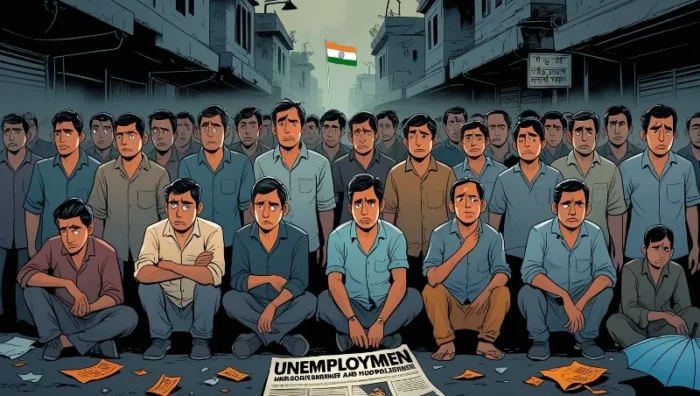India, one of the fastest-growing economies in the world, faces a significant social crisis that threatens the stability of its labor market – unemployment. Despite its robust economic growth and demographic advantage, India is confronted with an unemployment rate that remains uncomfortably high, particularly among its youth and rural populations. As the nation continues to develop, unemployment has emerged as one of the most pressing social and economic challenges that demands urgent attention.

Table of Contents
With over 1.4 billion people, India boasts the world’s largest youth population, yet millions of young men and women are struggling to find stable and meaningful employment. The reasons behind this crisis are complex and multifaceted, stemming from economic imbalances, structural issues, and global market changes.
In this context, addressing unemployment is not just an economic issue but a social imperative. Unemployment affects individuals’ sense of dignity, self-worth, and stability, and can fuel social unrest, economic inequality, and crime. This article explores the causes of unemployment in India, the impact it has on society, and the potential solutions that could help the country tackle this issue effectively.
1. The Causes of Unemployment in India
Economic Growth vs. Job Creation: While India has witnessed significant economic growth over the past few decades, the growth has not been inclusive enough to create jobs for the millions entering the workforce annually.
The nature of economic growth has also been highly concentrated in specific sectors, such as services and technology, with limited opportunities for manufacturing and agriculture, which still employ a large portion of the population.
Skill Mismatch: One of the biggest challenges in tackling unemployment is the mismatch between the skills possessed by the workforce and the skills required by employers. A large portion of India’s youth is equipped with theoretical knowledge but lacks the practical or vocational skills needed in the fast-evolving job market.
Automation and Technology: The global rise of automation and artificial intelligence (AI) has started to reshape industries, reducing the demand for human labor in several sectors. This trend has raised concerns about job displacement, particularly in manufacturing and low-skilled jobs.
Educational System Limitations: India’s education system is often criticized for its focus on rote learning and the lack of emphasis on practical skills, critical thinking, and entrepreneurship. Graduates frequently find themselves unemployable due to a lack of industry-relevant skills, exacerbating the unemployment problem.
Structural Issues in the Labor Market: India’s labor market has a significant portion of workers in the informal sector. Many of these workers do not have permanent contracts, social security, or other protections, leading to job insecurity. This lack of formal employment structures also makes it harder to measure the true scale of unemployment.
Population Growth: India’s rapidly growing population contributes to the strain on the job market. Every year, millions of young people enter the labor force, which increases competition for a limited number of jobs.
2. The Impact of Unemployment on Society
Social Unrest and Inequality: Unemployment has the potential to create social unrest. When large numbers of young people are without jobs, they may become frustrated, leading to protests, violence, or even criminal activities. Economic inequality is exacerbated as the unemployed or underemployed find it difficult to escape poverty.
Mental Health Issues: Joblessness often leads to feelings of worthlessness and anxiety, contributing to mental health challenges. The lack of financial security can lead to depression, stress, and other psychological issues, which affect individuals and their families.
Impact on Families: In many parts of India, the responsibility for providing financial support falls heavily on the shoulders of young adults. When these individuals are unable to find work, it can place a significant burden on families, particularly in rural areas where support systems may be weaker.
Migration to Urban Areas: The lack of employment opportunities in rural regions has led to significant migration to cities, where people hope to find better prospects. However, cities are often already overcrowded, and the migration exacerbates problems like slum development, inadequate housing, and poor public services.
3. Solutions to Tackling Unemployment
Addressing unemployment in India requires a multi-pronged approach that focuses on both short-term and long-term solutions. While there is no one-size-fits-all solution, several strategies can help address the crisis:
Promoting Skill Development: India must invest heavily in vocational training and skills development programs. Encouraging young people to acquire practical, market-driven skills will bridge the gap between education and industry needs. Partnerships between the government, educational institutions, and industries are essential for developing relevant training programs.
Supporting Entrepreneurship: To tackle unemployment, fostering an environment where entrepreneurship can flourish is crucial. Startup ecosystems, government incentives, and access to funding can help individuals create their own businesses, thereby creating jobs and boosting economic growth.
Investing in Rural Development: Strengthening the economy of rural India is essential for addressing the unemployment crisis. By improving infrastructure, providing access to education, promoting agricultural innovation, and supporting small businesses, rural areas can offer more opportunities for employment.
Encouraging Foreign Investment: Attracting foreign investments can create jobs and stimulate the economy. Simplifying regulations, providing incentives to international companies, and improving the ease of doing business can help make India an attractive destination for foreign capital.
Expanding the Manufacturing Sector: India needs to focus on strengthening its manufacturing sector by implementing policies that encourage innovation, streamline production processes, and create more jobs. The Make in India initiative is a step in the right direction, but it needs more focused implementation.
Improving the Education System: Reforming India’s education system to focus on critical thinking, problem-solving, and entrepreneurship will better equip students for the evolving job market. Emphasizing the importance of STEM (science, technology, engineering, and mathematics) education and digital literacy is key.
Government Schemes and Incentives: The government must introduce more employment generation schemes, especially in sectors such as construction, renewable energy, and technology. Schemes like Mahatma Gandhi National Rural Employment Guarantee Act (MGNREGA) can be expanded to provide more sustainable jobs in rural areas.
Job Creation through Infrastructure Development: Large-scale infrastructure projects, including smart cities, transportation networks, and renewable energy, can create thousands of jobs across the country. The government should prioritize public-private partnerships to fund and execute these projects efficiently.
Fostering Inclusivity: Ensuring that marginalized communities (e.g., women, Dalits, and tribals) have equal access to job opportunities is essential for reducing unemployment disparities. Employment policies must be inclusive and focus on providing opportunities to those who have historically been excluded from the formal labor market.
Enhancing Labor Market Flexibility: Improving labor laws to offer flexibility in hiring and firing can make it easier for businesses to hire workers, particularly in the formal sector. Reforms should ensure that labor rights are protected while providing employers with more hiring flexibility.
Conclusion
Unemployment in India is not just an economic issue; it is a social crisis that impacts the lives of millions of people. To solve this crisis, a coordinated effort between the government, private sector, educational institutions, and civil society is required.
By promoting skill development, entrepreneurship, rural development, and inclusive policies, India can create a future where every citizen has access to decent work and the opportunity to thrive.
Addressing unemployment will not only enhance the quality of life for millions but also fuel the economic growth and social stability of the nation.






